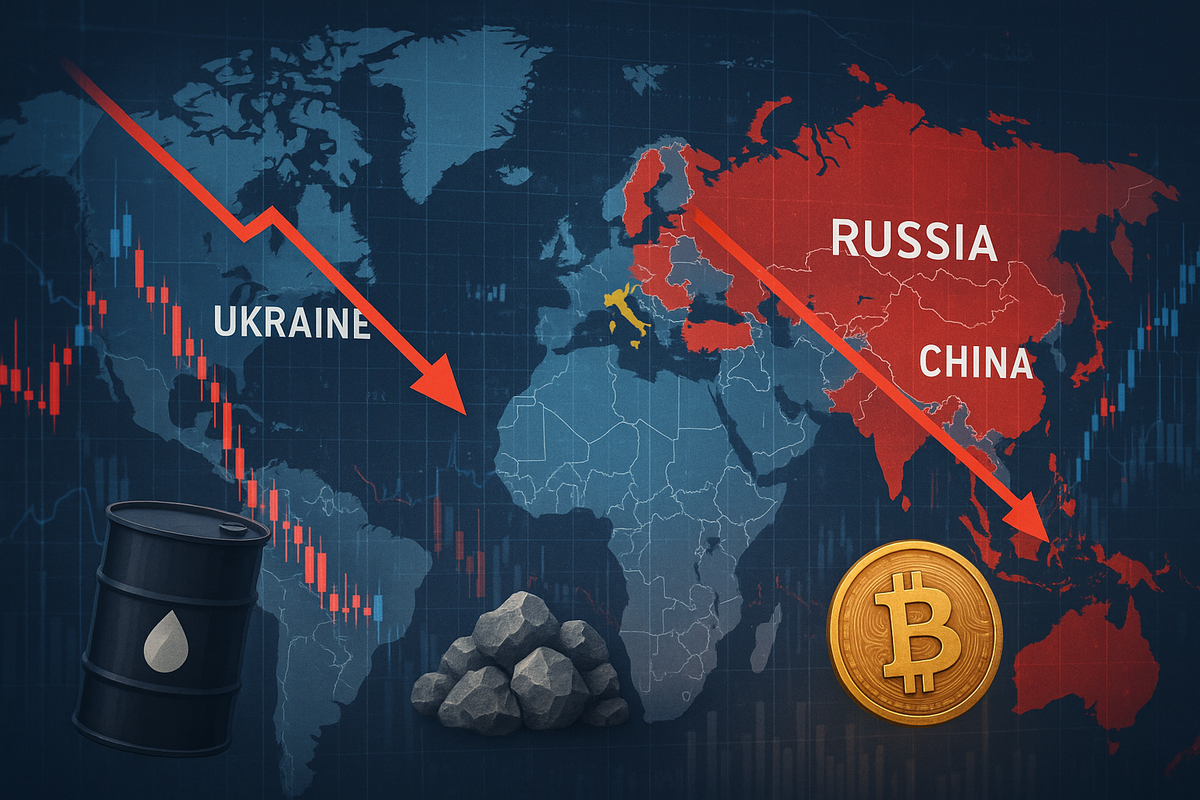
The global financial landscape is currently navigating a turbulent sea of geopolitical uncertainty, primarily driven by the protracted Russia-Ukraine conflict and significant, multifaceted developments emanating from China. These two major forces are not only reshaping international relations but are also exerting profound and often unpredictable impacts on global markets, commodity prices, and the very fabric of investor confidence. From the battlefields of Eastern Europe to the economic policy shifts in Beijing, the world is witnessing a rapid recalibration of supply chains, energy dependencies, and strategic alliances, forcing businesses and investors alike to adapt to a new, more volatile reality.
A World in Flux: The Unfolding Crises and Their Far-Reaching Implications
The ongoing Russia-Ukraine conflict, now well into its third year, continues to be a primary source of global instability. As of August 2025, peace talks remain largely stalled, with diplomatic efforts yielding limited breakthroughs. Russian forces continue to advance in eastern Ukraine, leveraging drone innovations and asymmetric tactics, while Ukraine has intensified its drone attacks on Russian energy infrastructure. These strikes, such as the catastrophic fire at the Novoshakhtinsk refinery in August 2025, which destroyed 1.5 million tons of oil and oil products, have crippled refining capacity and disrupted oil flows through critical pipelines like Druzhba. The reported deployment of 11,000 North Korean troops to Russia further underscores the conflict's potential for prolongation and its strain on global supply chains.
Simultaneously, China's economic and geopolitical trajectory presents another layer of complexity. The nation's economy is showing signs of strain, with Q2 2025 GDP growth of 5.2% masking underlying weaknesses such as faltering domestic demand, cooling industrial output, and a significant slump in property investment. Trade tensions with the U.S. have escalated, with tariffs exceeding 100% on Chinese goods, leading to a significant reconfiguration of global supply chains as U.S. companies cut investments in China to record lows. Furthermore, China has tightened its control over the global rare earth supply chain by expanding its quota system to include imported raw materials, a move that could significantly impact industries reliant on these critical minerals.
The immediate implications of these events are far-reaching. The Russia-Ukraine conflict continues to fuel volatility in global markets, particularly impacting European economies initially reliant on Russian gas. While the European STOXX 600 index is near record highs, sectors dependent on low energy prices, such as industrials and chemicals, have been significantly hit. Oil and gas prices remain elevated and volatile, directly influenced by Ukrainian attacks on Russian energy infrastructure. China's economic slowdown and trade tensions contribute to macroeconomic volatility, though calibrated stimulus measures and strength in other emerging markets like India offer some support. China's new rare earth regulations are expected to increase price volatility and reduce availability for non-Chinese manufacturers, accelerating efforts by other countries to develop alternative supply chains.
Navigating the Storm: Identifying the Winners and Losers
In this era of heightened geopolitical tension and economic recalibration, certain sectors and companies are emerging as beneficiaries, while others face significant headwinds. The aerospace and defense industry has experienced a supercharged rally since February 2022, with some companies seeing gains of over 600% to 1,500% as nations increase defense spending in response to the Russia-Ukraine conflict. Companies like Lockheed Martin (NYSE: LMT) and Raytheon Technologies (NYSE: RTX) are likely to continue seeing robust demand for their products and services.
The global energy transition has also accelerated, benefiting renewable energy companies and those involved in energy diversification. As Europe reduces its reliance on Russian gas, the demand for U.S. liquefied natural gas (LNG) has surged, benefiting LNG producers and exporters. Companies investing in solar, wind, and other clean energy technologies are also poised for growth, driven by the imperative to reduce dependence on fossil fuels. In China, exports of clean-energy technologies, including lithium-ion batteries and electric vehicles (EVs), have risen significantly, benefiting Chinese manufacturers in these sectors.
Conversely, European industrials and chemical companies that were heavily reliant on low-cost Russian energy have faced significant challenges due struggling with higher input costs. Companies with extensive supply chains deeply integrated with Russia or Ukraine have also incurred substantial costs in re-routing and diversifying their logistics. Furthermore, industries heavily dependent on Chinese rare earths, such as EV manufacturing, wind turbine production, consumer electronics, and defense systems outside of China, face potential vulnerabilities due to Beijing's tightened control over these critical materials. This could impact major global players like Tesla (NASDAQ: TSLA) or Siemens Gamesa Renewable Energy (BME: SGRE) if they cannot secure alternative sources or face increased costs. Companies with significant investment exposure to China, particularly U.S. firms, are also scaling back due to trade policy uncertainty and tariffs, impacting their growth prospects in the region.
Industry Impact and Broader Implications: A Reshaped Global Economy
The geopolitical events of the past few years have not merely caused temporary market fluctuations; they are fundamentally reshaping global industries and international economic structures. The Russia-Ukraine conflict has irrevocably accelerated the global energy transition, reinforcing the case for diversification away from fossil fuels and driving massive investments in renewables. This shift has profound implications for the oil and gas industry, pushing it towards greater scrutiny and potentially faster decarbonization, while simultaneously creating opportunities for renewable energy developers and energy storage solution providers. The conflict has also led to a significant reconfiguration of global supply chains, particularly for food and energy, with companies actively seeking to de-risk by diversifying sourcing and manufacturing locations. This trend, often termed "friend-shoring" or "near-shoring," is a long-term structural change impacting logistics, manufacturing, and trade flows worldwide.
China's developments are equally transformative. The escalating U.S.-China trade tensions are driving a broader decoupling, forcing companies to re-evaluate their global manufacturing footprints. This has led to increased investment in alternative production hubs in Southeast Asia, India, and Mexico, impacting global manufacturing and logistics. China's tightened control over rare earth elements, which are crucial for high-tech industries, is a strategic move that could grant it significant leverage over global technology supply chains. This policy will likely spur other nations to invest heavily in domestic rare earth mining and processing capabilities, creating new industries and supply chains outside of China. Furthermore, China's Belt and Road Initiative (BRI), particularly with the recent Central Asia Treaty in June 2025, is institutionalizing its influence across Eurasia, reshaping regional trade and infrastructure development and potentially challenging existing international financial institutions. This fits into a broader trend of a more multipolar world order, where economic and political power is increasingly distributed.
What Comes Next: Navigating Uncertainty and Seizing Opportunities
Looking ahead, the global economy is likely to remain in a state of flux, characterized by continued volatility and the need for strategic adaptation. In the short term, the Russia-Ukraine conflict's trajectory will heavily influence energy prices and European economic sentiment. Any significant escalation or de-escalation could trigger immediate market reactions. Similarly, China's economic data, particularly regarding domestic consumption and property market stability, will be closely watched for signs of recovery or further slowdown. The ongoing U.S.-China trade negotiations and any new tariff announcements will also dictate the pace of supply chain reconfiguration.
In the long term, the push for energy independence and diversified supply chains will continue. This will create sustained opportunities for companies in renewable energy, defense, and logistics solutions that can offer resilient and geographically diverse options. Countries will likely increase investments in critical mineral extraction and processing to reduce reliance on single sources. The geopolitical rivalry between major powers is expected to intensify, leading to further strategic pivots in trade, technology, and defense policies. Investors should anticipate continued market opportunities in sectors benefiting from these shifts, such as cybersecurity, advanced manufacturing, and infrastructure development in emerging markets. However, challenges will persist in managing inflation, navigating complex regulatory environments, and assessing geopolitical risks. Potential scenarios range from a prolonged, low-intensity conflict in Ukraine with continued economic decoupling between the U.S. and China, to more significant diplomatic breakthroughs or, conversely, further escalations that could trigger broader economic shocks.
Conclusion: A New Era of Geopolitical Economics
The current geopolitical landscape, dominated by the Russia-Ukraine conflict and China's evolving influence, marks a significant turning point for the global economy. The era of seamless globalization, characterized by optimized, just-in-time supply chains and stable energy markets, is giving way to a more fragmented and risk-averse environment. Key takeaways include the persistent nature of geopolitical risk as a primary market driver, the irreversible reconfiguration of global supply chains, and the accelerated shift towards a diversified and decarbonized energy future.
Moving forward, markets will continue to be highly sensitive to geopolitical developments. Investors should prioritize resilience and diversification in their portfolios, focusing on companies and sectors that are well-positioned to adapt to these structural changes. This includes businesses with strong balance sheets, diversified revenue streams, and robust supply chain management. What investors should watch for in the coming months are any signs of diplomatic progress in the Russia-Ukraine conflict, further actions by central banks regarding interest rates (especially the U.S. Federal Reserve's potential rate cuts), significant shifts in commodity prices, and China's policy responses to its economic challenges and trade tensions. The lasting impact of these events will be a more complex, multipolar world where geopolitical considerations are inextricably linked with economic outcomes, demanding a more nuanced and adaptive approach from all market participants.








